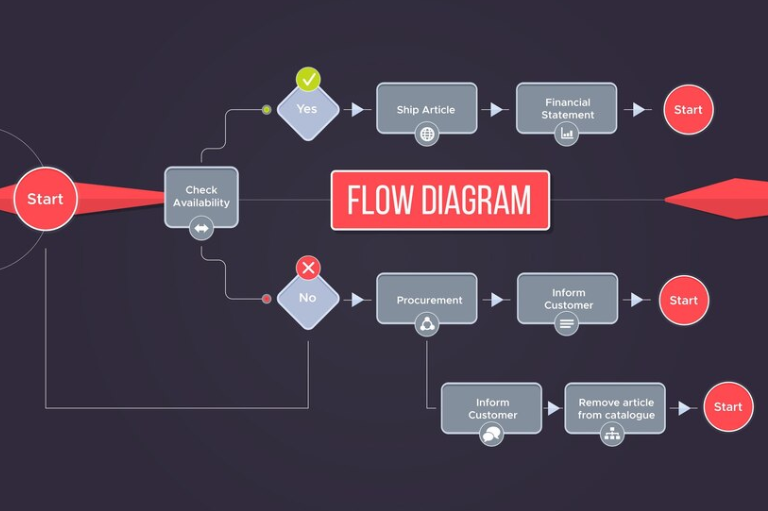Navigating the complex world of business can often feel like trying to solve a labyrinth without a map. Enter business flowchart mapping—a powerful tool that can transform the way you understand and manage your operations. Whether you’re a budding entrepreneur or a seasoned professional, mastering the art of flowchart mapping can offer unparalleled clarity and efficiency in your business processes.
Why Business Flowchart Mapping Matters
In today’s fast-paced business environment, clarity and efficiency are more important than ever. Business flowchart mapping serves as a visual representation of a process, showing the sequence of steps and how they relate to one another. This makes it easier to identify bottlenecks, streamline operations, and improve communication within your team. Hence, consider doing a Business flowchart mapping course.
Simplifying Complex Processes
One of the most compelling reasons to learn business flowchart mapping is its ability to simplify complex processes. Imagine trying to explain a complicated procedure through text alone—it’s both time-consuming and prone to misunderstandings. A flowchart, however, provides a clear visual representation that’s far easier to grasp.
Enhancing Communication
Effective communication is the backbone of any successful business. Flowcharts serve as a universal language that everyone in your organization can understand, from entry-level employees to top executives. This ensures that everyone is on the same page, reducing the likelihood of errors and increasing overall productivity.
Identifying Bottlenecks
In any business process, bottlenecks can slow down operations and lead to inefficiencies. Flowchart mapping allows you to pinpoint these problem areas quickly, making it easier to implement corrective measures. This not only saves time but also improves the overall efficiency of your business.
Getting Started with Flowchart Mapping
Choosing the Right Tools
Before you can start creating flowcharts, you need the right tools. There are various software options available, from basic drawing tools like Microsoft Visio to more advanced options like Lucidchart and SmartDraw. These tools offer a range of features that can make the process of creating flowcharts much easier.
Understanding Flowchart Symbols
Flowcharts use a variety of symbols to represent different types of actions or steps in a process. Common symbols include ovals for start and end points, rectangles for tasks, diamonds for decision points, and arrows to show the flow of the process. Familiarizing yourself with these symbols is crucial for creating effective flowcharts.
Defining Your Objectives
Before you start mapping out your business processes, it’s essential to define your objectives. What do you hope to achieve with your flowchart? Are you looking to improve efficiency, enhance communication, or identify bottlenecks? Having clear objectives will guide your flowchart creation process and ensure that it meets your needs.
Creating a Flowchart
Step-by-Step Process
Creating a flowchart involves several steps. First, you’ll need to outline the process you want to map. This involves identifying all the tasks involved and how they relate to each other. Once you have a clear outline, you can start creating your flowchart using the symbols and tools you’ve chosen.
Reviewing and Refining
Once you’ve created your flowchart, it’s essential to review it carefully. Look for any areas that are unclear or could be simplified. You may also want to get feedback from other team members to ensure that the flowchart is easy to understand and accurately represents the process.
Implementing Changes
After you’ve reviewed and refined your flowchart, it’s time to implement any changes. This may involve updating your processes, retraining staff, or making other adjustments to ensure that your business runs more smoothly. The goal is to create a more efficient and effective operation.
Practical Applications of Flowchart Mapping
Streamlining Operations
One of the main benefits of flowchart mapping is its ability to streamline operations. By providing a clear visual representation of a process, flowcharts make it easier to identify inefficiencies and implement improvements. This can lead to significant time and cost savings for your business.
Improving Training
Flowcharts are also an excellent tool for training new employees. They provide a clear, easy-to-understand representation of processes, making it easier for new hires to get up to speed quickly. This can reduce the time and cost associated with training and improve overall productivity.
Enhancing Problem-Solving
When problems arise, having a clear understanding of your processes can make it easier to identify the root cause and implement effective solutions. Flowcharts provide a visual representation of your processes, making it easier to see where things might be going wrong and take corrective action.
Advanced Flowchart Techniques
Using Swimlanes
Swimlanes are a technique used to group related tasks in a flowchart. This can make it easier to see how different parts of a process relate to each other and identify areas for improvement. Swimlanes can be particularly useful for complex processes that involve multiple departments or teams.
Integrating Data
In addition to visual representations, flowcharts can also incorporate data to provide additional insights. For example, include metrics such as time taken for each task or error rates. This can help you identify areas for improvement and track the impact of any changes you make.
Automating Flowchart Creation
With the right tools, you can automate the creation of flowcharts. This can save time and ensure that your flowcharts are always up-to-date. Many flowcharting tools offer integration with other business software, allowing you to generate flowcharts based on real-time data automatically.
Real-World Examples of Flowchart Success
Case Study 1: Manufacturing Efficiency
A manufacturing company used flowchart mapping to streamline their production process. By identifying bottlenecks and inefficiencies, they were able to reduce production time by 20% and increase overall output. The flowcharts provided a clear roadmap for implementing changes and tracking their impact.
Conclusion
Business flowchart mapping is a powerful tool that transforms the way you understand and manage operations. It provides a clear visual representation, helping identify inefficiencies, improve communication, and streamline operations. Sign up for a free consultation to explore its potential and start transforming your business today.









